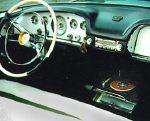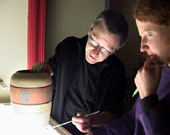Real Discoveries Dismissed as Hoaxes —
Status: Not Hoaxes
A few days ago the
Financial Times ran a brief list of major technological breakthroughs that were either ignored or ridiculed. This raises an interesting issue: the danger of over-skepticism, or dismissing startling new discoveries as hoaxes simply because one refuses to believe that anything new or out-of-the-ordinary can be real. I can't find a link to the FT story, but here's a summary of their list:
The Wright Brothers' discovery of flight: "When two American bicycle repairmen claimed to have built the world's firstaircraft in 1903, they were dismissed as cranks. Newspapers refused to send reporters or photographers to witness any of the flights. More than two years later, Scientific American magazine was still insisting that the story was a hoax. By that time, the Wright brothers had completed a half-hour flight covering 24 miles."
Steam Turbine Propulsion: "The claim of Irish engineer Charles Parsons to have developed a radically new form of marine propulsion was scorned by the Admiralty, until his steam turbine vessel made an unauthorised appearance at the 1897 Spithead naval review going at 37 knots - faster than any other vessel in the fleet."
Atoms as a source of energy: "The idea that atoms could be a source of energy millions of times more potent than coal or oil was dismissed by the Nobel Prize-winning physicist Ernest Rutherford as "moonshine"."
Amorphous semiconductor materials: "During the 1950s, self-taught American physicist Stanford Ovshinsky found a way of creating materials lacking a regular crystal structure - an achievement dismissed as impossible by scientists. They are now standard components in devices ranging from flat-panel displays to solar cells."
Lasers: "While developing the technology behind the laser, American physicist Charles Townes was approached by two Nobel-Prize-winning colleagues who told him he was wasting his time and threatening their funding. Even after the first laser was built in 1960, it was described as "a solution looking for a problem"."
The Scanning Tunnelling Microscope: "The Scanning Tunnelling Microscope (STM), invented by scientists at IBM in Zurich in the early 1980s, now plays a key role in fields ranging from biology to nanotechnology. But many scientists remained deeply suspicious of the claims made for the STM until its inventors won the Nobel Prize for physics in 1986."
To this list I can add:
Photography: Marcus Aurelius Root, a 19th century American photographer, recorded that: "In 1839, and on the very day of the publication of Daguerre's discovery in the Philadelphia daily papers, Dr. Bird, then chemical professor in one of our medical schools, was asked, at a gathering of several scientific men, what he thought of this new method of copying objects with the sunbeam? The Doctor, in a lengthened reply, pronounced the whole report a fabrication--a new edition of the famed "
moon-hoax"--such a performance being, in his view, an intrinsic improbability."
The Duckbilled Platypus. When George Shaw, keeper of the Department of Natural History at the British Museum, examined a specimen of a
duckbilled platypus sent to him from Australia, he wrote that, "it is impossible not to entertain some doubts as to the genuine nature of the animal, and to surmise that there might have been practised some arts of deception in its structure."
Of course, all these real discoveries that were regarded as hoaxes provide an endless source of encouragement to all the crackpots who are convinced that their devices for extracting infinite energy from magnets, or using water as a fuel, are similarly misunderstood.

 Wired has an interesting article about Hiroshi Ishiguro, a Japanese researcher who has built a remote-control robotic version of himself:
Wired has an interesting article about Hiroshi Ishiguro, a Japanese researcher who has built a remote-control robotic version of himself:  Did car manufacturers ever offer the option of an in-car phonograph? I would have thought not. After all, the technological challenge presented by such a product is obvious. How can you get it not to skip? But trusting in the common sense of car manufacturers is never a wise thing to do. So in this respect it's probably obvious that, yes, such a feature was once offered, though for a very brief period of time. Predictably, the in-car phonographs skipped like crazy and were pulled from the market.
Did car manufacturers ever offer the option of an in-car phonograph? I would have thought not. After all, the technological challenge presented by such a product is obvious. How can you get it not to skip? But trusting in the common sense of car manufacturers is never a wise thing to do. So in this respect it's probably obvious that, yes, such a feature was once offered, though for a very brief period of time. Predictably, the in-car phonographs skipped like crazy and were pulled from the market.
 Meet Genpets, the cute, cuddly (kind of ugly) pets of the future, that come shrinkwrapped in plastic:
Meet Genpets, the cute, cuddly (kind of ugly) pets of the future, that come shrinkwrapped in plastic:  A video on YouTube shows a MacBook Pro that has supposedly been hacked to rapidly change applications whenever it's smacked on the side. (Thanks to Kathy for sending the link.) I have to admit that when I first saw it, I thought it was fake. I figured the guy was probably pushing a button to make the applications change. However, after reading Erling Ellingsen's description on Medallia blog of how the SmackBook was created, I'm now pretty sure it's real. He writes:
A video on YouTube shows a MacBook Pro that has supposedly been hacked to rapidly change applications whenever it's smacked on the side. (Thanks to Kathy for sending the link.) I have to admit that when I first saw it, I thought it was fake. I figured the guy was probably pushing a button to make the applications change. However, after reading Erling Ellingsen's description on Medallia blog of how the SmackBook was created, I'm now pretty sure it's real. He writes:  The U.S. Patent Office recently awarded patent number 7037243 to Lester Clancy, inventor of the cordless jump rope. It's a jump rope without the rope. I guess you could call it an 'air rope'. However, it does have handles. Here's the description from the patent:
The U.S. Patent Office recently awarded patent number 7037243 to Lester Clancy, inventor of the cordless jump rope. It's a jump rope without the rope. I guess you could call it an 'air rope'. However, it does have handles. Here's the description from the patent:  The JATO (jet-assisted take-off) car is one of the most famous urban legends of all time. (Man attaches JATO unit to the top of his Chevy Impala, fires it up on a deserted Arizona highway, and launches himself into a nearby cliff at 300 mph.) But the San Francisco Chronicle reports about a man, Ron Patrick, who has built a real-life JATO car. It's a silver Volkswagen with a huge jet engine sticking out the back. It's very cool. I want one. Patrick gave this description of turning on the jet engine while driving:
The JATO (jet-assisted take-off) car is one of the most famous urban legends of all time. (Man attaches JATO unit to the top of his Chevy Impala, fires it up on a deserted Arizona highway, and launches himself into a nearby cliff at 300 mph.) But the San Francisco Chronicle reports about a man, Ron Patrick, who has built a real-life JATO car. It's a silver Volkswagen with a huge jet engine sticking out the back. It's very cool. I want one. Patrick gave this description of turning on the jet engine while driving: Last week Nintendo announced that it was renaming its soon-to-be-released console. The former name was Revolution. The new name? Wii. Barely had the name passed Nintendo's lips, than the snickering and outrage from the gaming community began. As one person astutely put it, "It means piss. For god's sake, it means PISS!" (It also means little in Scottish, but no one seems as upset about that.)
Last week Nintendo announced that it was renaming its soon-to-be-released console. The former name was Revolution. The new name? Wii. Barely had the name passed Nintendo's lips, than the snickering and outrage from the gaming community began. As one person astutely put it, "It means piss. For god's sake, it means PISS!" (It also means little in Scottish, but no one seems as upset about that.) I'm no aeronautical engineer, so I'm not qualified to say if the plane featured on the website of JCR Technology could fly or not, though it sure doesn't look to me like it would ever get off the ground. Apparently it's supposed to fly by means of eight flapping wings, located on either side of the plane. The website is entirely in French, so I can't determine if this is simply some kind of thought experiment, or a real plane that someone is trying to build. Definitely check out the computer-graphic simulations of the plane flying (look under the 'images' tab). Even in the simulations, it doesn't look like it could fly. There's a photostream on Flickr showing a crosssection of this plane being displayed at the Salon International des Inventions in Geneva, which seems to be a convention for people with crazy inventions.
I'm no aeronautical engineer, so I'm not qualified to say if the plane featured on the website of JCR Technology could fly or not, though it sure doesn't look to me like it would ever get off the ground. Apparently it's supposed to fly by means of eight flapping wings, located on either side of the plane. The website is entirely in French, so I can't determine if this is simply some kind of thought experiment, or a real plane that someone is trying to build. Definitely check out the computer-graphic simulations of the plane flying (look under the 'images' tab). Even in the simulations, it doesn't look like it could fly. There's a photostream on Flickr showing a crosssection of this plane being displayed at the Salon International des Inventions in Geneva, which seems to be a convention for people with crazy inventions.



 The Raw Feed has linked to a video (in French) in which Belgian archaeologists discuss how they were able to "use computer scans of the grooves in 6,500-year-old pottery to extract sounds -- including talking and laughter -- made by the vibrations of the tools used to make the pottery." The video is fairly good quality and would lead you to believe that it might be real, if it weren't for the premise being pretty farfetched (and not reported anywhere else in the news). Make Magazine reports that the video was created last year as an April Fool's Day hoax, and point out that "This site - 'Poisson d'avril de journal televise', translates to: 'April fools newscast'." (However, I can't find any mention of Poisson d'avril in the site they link to.) Other Make readers point out that the premise (audio extracted from ancient pottery) was ripped off (pun intentional) from a story by Gregory Benford, Time Shards. (Thanks to Schmawy for the link)
The Raw Feed has linked to a video (in French) in which Belgian archaeologists discuss how they were able to "use computer scans of the grooves in 6,500-year-old pottery to extract sounds -- including talking and laughter -- made by the vibrations of the tools used to make the pottery." The video is fairly good quality and would lead you to believe that it might be real, if it weren't for the premise being pretty farfetched (and not reported anywhere else in the news). Make Magazine reports that the video was created last year as an April Fool's Day hoax, and point out that "This site - 'Poisson d'avril de journal televise', translates to: 'April fools newscast'." (However, I can't find any mention of Poisson d'avril in the site they link to.) Other Make readers point out that the premise (audio extracted from ancient pottery) was ripped off (pun intentional) from a story by Gregory Benford, Time Shards. (Thanks to Schmawy for the link)
 No, it's not possible to cook an egg with two cell phones. At least, not by using the method outlined on wymsey.co.uk. The instructions basically boil down to this: place an egg between two phones, use one phone to call the other, and then wait for radio signals to cook the egg. Wymsey notes that cooking time:
No, it's not possible to cook an egg with two cell phones. At least, not by using the method outlined on wymsey.co.uk. The instructions basically boil down to this: place an egg between two phones, use one phone to call the other, and then wait for radio signals to cook the egg. Wymsey notes that cooking time:

 Odd, but real. Hammacher Schlemmer is selling a seven-person bicycle. (Actually, bicycle is inaccurate. It's a tricycle.) The blurb about it says: "The frame has an ergonomic design making it easy to get on and off, and has seven sets of pedals that propel the trike forward via a patented transmission system. One person steers, while all seven riders are free to pedal, or not, as the bike moves along." You'd look real cool going down to the store to pick up a loaf of bread on this thing, especially if you then try to chain it up in the bike rack. (Thanks to Daniel Folk for the link.)
Odd, but real. Hammacher Schlemmer is selling a seven-person bicycle. (Actually, bicycle is inaccurate. It's a tricycle.) The blurb about it says: "The frame has an ergonomic design making it easy to get on and off, and has seven sets of pedals that propel the trike forward via a patented transmission system. One person steers, while all seven riders are free to pedal, or not, as the bike moves along." You'd look real cool going down to the store to pick up a loaf of bread on this thing, especially if you then try to chain it up in the bike rack. (Thanks to Daniel Folk for the link.)